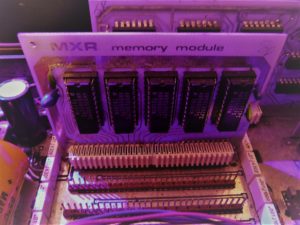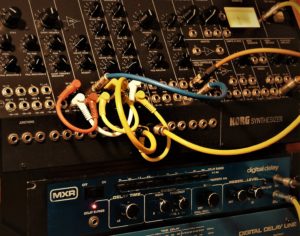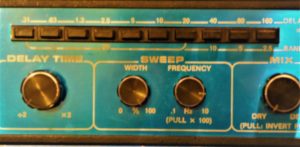The MXR M-113 Digital Delay has been one of the most popular first generation audio delays, as it had a good quality but was more affordable than the previous processors. Introduced in ’76 at around 1000 USD, it was still expensive, but a lot less than the other digital delays available in the market.
MXR was specialized in guitar pedals, this delay was instead offered in a 19″ rack unit and, same as the other effects of the professional rack series, (Flanger/Doubler, Graphic EQ, Pitch Transposer) became very popular and used by famous artists such as David Gilmour, Frank Zappa, Roger Waters, Brian May and Mike Rutherford.
Modular

To contain costs, a modular architecture was chosen. Optional memory boards were inserted in slots, to increase the delay time, but these were pretty expensive, costing almost like a complete unit.

Digital noise..well not only that! :D
Unfortunately the M-113 Digital Delay, same as its collegues of the same period, is pretty noisy and not only referring to the actual standards. Apart digital noises always present, these processors have a marcated tendency to generate audio hum.
The Model 113, Digital Delay has a maximum bandwidth of 20KHz, but this decreases with longer delays, down to 2.5KHz. The longer the time between repetitions, the tighter the passing frequency band, being reduced through antialiasing filters (HPF and LPF) the more the delay time is increased.
MXR Digital Delay Test Drive
As there a re several video examples already of this delay tested on guitar, I thought it could have been a good idea to try it, using some unusual but hopefully interesting sounds.
re several video examples already of this delay tested on guitar, I thought it could have been a good idea to try it, using some unusual but hopefully interesting sounds.
To record, I used a dbx DI box and the signal sent to a Universal Audio 610 tube preamp, even taking all possible counter-measures, still a bit of hum is audible.
On the examples below, I feeded as sound source, a sweep from the filters in feedback of an old Korg MS-50 synthesizer, some piano chords I had recorded from a real piano and a couple of seconds of an oldschool reggae classic.
MXR Digital Delay, Test-01, (MS-50 Filter Sweep)
01) Dry sound, straight from the MS-50.
02) Delay Range 160ms, Delay Time x2, 50% mix and maximum regen (feedback)
03) Delay Range 160ms, Delay Time 0, 50% mix and maximum regen (feedback)
04) Delay Range 160ms, Delay Time 1/2, 50% mix and maximum regen (feedback)
05) Delay Range 160ms, Delay Time Sweep 01 (moving the Delay Time knob)
06) Delay Range 160ms, Delay Time Sweep 02 (moving the Delay Time knob)
MXR Digital Delay, Test-02 (Piano)
I chose these piano chords I recorded as, having long decays, are ideal to test the effect of short repetitions, when modulated. The effects space from phasing to complete madness. The last one is a strong modulation at the higher band of frequency of the sweep, reminding the effect of a ring modulation.
1) Dry Piano
2) Delay Range 1.3ms, 50% mix
3) Delay Range 10ms, 50% mix
4) Delay Range 160ms, 50% + Mod
5) Max Frequency Mod
MXR Digital Delay, Test-03 (Rhythmic Loop)
 On the following examples, let’s try something that really impressed me first time I played with a Powertran (An article on it, is coming soon). On the MXR the feedback has a faster decay and there’s not the “freeze” function, but the effect it is interesting, too. Once the delay is at tempo with a rhythmic pattern, having adjusted the decay time knob, all Delay Range buttons create a different version of the pattern, but on different speeds. Being the buttons based on a double time sequence, all these are compatible in tempo. Let’s experiment with a small classic reggae riddim loop:
On the following examples, let’s try something that really impressed me first time I played with a Powertran (An article on it, is coming soon). On the MXR the feedback has a faster decay and there’s not the “freeze” function, but the effect it is interesting, too. Once the delay is at tempo with a rhythmic pattern, having adjusted the decay time knob, all Delay Range buttons create a different version of the pattern, but on different speeds. Being the buttons based on a double time sequence, all these are compatible in tempo. Let’s experiment with a small classic reggae riddim loop:
1) Dry loop
2) Loop effected as sort of Beat Repeater
MXR Digital Delay, Test-04 (MS-50 patch)
Last example, this time using a more complex sound from the MS-50.
1) Dry MS-50 sound
2) MXR MS – 50%MIX, 75% Feedback
3) MXR MS – 50%MIX, 75% Feedback + Mod
4) MXR MS – 50%MIX, 75% Feedback + Fast Mod
Service Manual: https://app.box.com/s/4t78o8xtzd


thank you for the history lesson! I Personally love the artifacts of analogue fx. Even using emulators I try to engineer stacks to mimic the noise and “lo-fi” of the old school methods. I truly appreciate your understanding and experience. Thank you for passing on your insight!
Really glad you found the article interesting!
I’m writing a new one on the Powertran Digital Delay, I hope you will enjoy it too, the processor is one of my preferred and there’s not too much written on it! Many thanks the nice comment! :)
Interesting article man, MXR sounds amazing on the reggae snippets!
Thanks Spiralizer, really kind. :) Stay tuned, next article will be about my favorite digital delay, an 8-bit crazy one!
Were you able to find out what kind of Delay chips were driving the unit? I noticed the RAM chips on the memory module but wasnt able to see what the other IC’s were. Great stuff man.
Thanks for your comment!
Apart from the schematics, searching online I had found an interesting article on how this machine works:
http://www.tauntek.com/MXR113cktdescr.pdf Let me know if you need something more, I have the unit here, easily inspectable.
Thank you for the above! Fantastic.
I acquired one of these a long time ago and just starting using it as part of my live rig. I’m a trumpet player and play electric with efx a lot. I can’t find a manual for this thing anywhere. Not the repair schematics but the actual manual. Any idea where I can download it? There are things about this unit I do not yet understand but so far just experimenting I LOVE IT. Thanks for any help!
Todd
Congratulations, this is a great delay, you’ll have lots of fun playing through it! Unfortunately, I have no idea where you can find the manual, but being this a pretty successful gear, I’m surprised there isn’t a copy available online. The front panel is pretty basic, you shouldn’t find particular problems once you get used to the names of the parameters. (Example: Regen. stays for Feedback and Sweep is the LFO)
Good luck!!
I’m looking for a repair facility for an MXR 113 digital delay. I Tried Dunlop (MXR); no help.
I have a manual and the supplement for the MXR 113 digital delay that I can scan and send to the person looking for them.
If you have the service manual too, that would be very helpful to repair your machine.
Sorry I have no idea about repair facilities for these machines. May I know what’s wrong with your digital delay?
Wow! I just happened back here, read my comment and question about a manual for the MXR 113 and had no idea there had been a reply. Thank you very much for that offer. I would appreciate it very much. Does my email address show on your end?
Todd